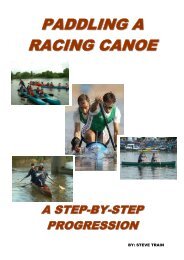The Science of Canoeing By Richard Cox
The Science of Canoeing By Richard Cox
The Science of Canoeing By Richard Cox
Create successful ePaper yourself
Turn your PDF publications into a flip-book with our unique Google optimized e-Paper software.
Synergist (or neutralisers). Many muscles act over two or more joints. In certain co-ordinated actions, not all the<br />
joints controlled by the prime mover may be required to move and a muscle or group <strong>of</strong> muscles is therefore<br />
required to prevent any undesired joint movement For example, if a prime mover muscle flexes and rotates, but<br />
only rotation is required, an extensor muscle might work statically to counter balance or neutralise the flexor<br />
action <strong>of</strong> the prime mover. <strong>The</strong> action <strong>of</strong> the extensor muscle is known as synergic muscle action and makes the<br />
prime mover more effective because the force <strong>of</strong> contraction is directed solely towards the desired action. In<br />
extension <strong>of</strong> the shoulder joint during the pull phase the infraspinatus and teres minor contract to prevent inward<br />
rotation.<br />
Regardless <strong>of</strong> the movement or exercise performed, it will be appreciated that a vast and complex network <strong>of</strong><br />
muscular action takes place however simple the movement may appear. Often when people analyse a<br />
movement, or devise an exercise to strengthen it, only the prime movers are given consideration. Similarly,<br />
when attempting to define the action <strong>of</strong> a muscle, the many varied ways in which the muscle takes part are <strong>of</strong>ten<br />
overlooked.<br />
Before identifying the different joints and muscle groups employed in canoeing and the functions they perform,<br />
one must first analyse technique. Before doing that, it would be helpful to learn how bodily movements are<br />
described by the sports scientist. This will help one understand some <strong>of</strong> the terminology used later in the course<br />
<strong>of</strong> the text<br />
Movement Reference System<br />
Planes<br />
To describe bodily movements sports scientists first identify the plane in which they take place. Three planes,<br />
each lying at right angles to each others are used.<br />
Sagittal Plane<br />
<strong>The</strong> sagittal plane is a vertical plane which passes through the body from front to rear as if bisecting it into two<br />
37



